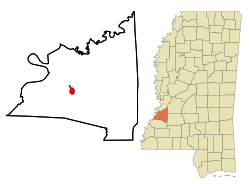Port Gibson, Mississippi
| Port Gibson, Mississippi | |
|---|---|
| City | |

Claiborne County Courthouse in Port Gibson
|
|
 Location of Port Gibson, Mississippi |
|
| Location in the United States | |
| Coordinates: 31°57′22″N 90°58′59″W / 31.95611°N 90.98306°WCoordinates: 31°57′22″N 90°58′59″W / 31.95611°N 90.98306°W | |
| Country | United States |
| State | Mississippi |
| County | Claiborne |
| Area | |
| • Total | 1.8 sq mi (4.5 km2) |
| • Land | 1.8 sq mi (4.5 km2) |
| • Water | 0.0 sq mi (0.0 km2) |
| Elevation | 118 ft (36 m) |
| Population (2010) | |
| • Total | 1,567 |
| • Density | 870/sq mi (350/km2) |
| Time zone | Central (CST) (UTC-6) |
| • Summer (DST) | CDT (UTC-5) |
| ZIP code | 39150 |
| Area code(s) | 601 |
| FIPS code | 28-59560 |
| GNIS feature ID | 0676254 |
Port Gibson is a city in Claiborne County, Mississippi, United States. The population was 1,567 at the 2010 census. Port Gibson is the county seat of Claiborne County and home to the Claiborne County Courthouse.
The first European settlers in Port Gibson were French colonists in 1729; it was part of La Louisiane. It was chartered as a town in the U.S. in 1803 after the Louisiana Purchase. Due to development of cotton plantations in the area after Indian Removal, planters in the state imported thousands of African-American slaves from the Upper South. The county had a black majority established well before the Civil War; they were overwhelmingly enslaved.
Several notable people are native of Port Gibson. The town saw action during the American Civil War. Port Gibson has several historical sites listed on the National Register of Historic Places (National Register of Historic Places listings in Claiborne County, Mississippi).
In the 20th century, Port Gibson was home to The Rabbit's Foot Company, which had a substantial role in the development of blues in Mississippi, including taverns and juke joints now included on the Mississippi Blues Trail. With the decline in agriculture and lack of other jobs, the city and county have suffered from reduced population and poverty. The peak of population in the city was in 1950. A report in the New York Times in 2002 characterized Port Gibson as 80 percent black and poor, with 20 percent of families living on incomes less than $10,000 a year according to the 2000 Census. It also has an "entrenched population of whites, many of whom are related and have some historical connection to cotton."
...
Wikipedia

